
The Big Horn Armory Model 89 takes the classic lever-action platform and packs it with .500 S&W Mag. power.
For more information, visit https://www.bighornarmory.com/catalog/1/big-horn-armory-products/.
To purchase on GunsAmerica.com, click this link: https://www.gunsamerica.com/Search.aspx?T=big%20horn%20armory.
Ever since the .500 Smith & Wesson Magnum came on the scene in 2003, there have been a bunch of folks trying to figure out how to cram the cartridge into a rifle—especially a lever-action rifle. It’s an American obsession ever since the cowboy days: A guy “needs” to have a lever-action rifle chambered for his handgun cartridge. Whether that need is real or not can be debated elsewhere, but the perception remains steadfast. Most of the popular revolver cartridges—from the .32-20 to the .45 Colt—have been chambered in a lever-action rifle. However, when it comes to the .500 S&W Mag there are a few dimensional problems in getting that cartridge to fit into an established platform.
SPECS
- Chambering: .500 Smith & Wesson Magnum
- Barrel: 22 inches (rifle); 18 inches (carbine)
- OA Length: 41 inches (rifle); 37 inches (carbine)
- Weight: 7 lbs., 14 oz. (rifle); 7 lbs., 10 oz. (carbine)
- Stock: American black walnut
- Sights: Rear, aperture adjustable for elevation and windage; brass bead front
- Action: Lever action
- Finish: Blued or stainless steel
- Capacity: 5 (rifle); 7 (carbine)
- MSRP: $2,699 (starting price)
Enter Greg Buchel and Dan Brown. Buchel has a background in architecture and engineering, and Brown is a master machinist. Both are gunners. About five years ago they partnered up to figure out how to marry the .500 S&W Mag to a handy lever-action rifle, calling the new company Big Horn Armory (BHA). One of the most successful lever actions chambered in handgun cartridges is the Winchester Model 92. This super-slick brainchild of John Browning took its wildly popular pappy—the Model 1886—and shrank it proportionately to accommodate the smaller pistol cartridges. But, alas, the Model 92 is just too small for the big S&W cartridge.
Buchel, an accomplished engineer and Autocad designer, and Brown decided to upsize the Model 92 to harness the new chambering. The net result amounts to be a 50-percent increase in size and mass throughout the rifle. One regular complaint about the ’92 is the dinky loading gate. Especially with larger cartridges like the .44-40, .44 Special/Mag and .45 Colt, it can become downright painful to load the magazine more than a couple of times a day. Due to the length of the .500 S&W Mag case, Buchel and Brown decided to adapt the loading gate design on the Model 1886 to the new action. Loading is not as challenging as it can be with a ’92, but after a day of loading some 70 rounds, my thumb is a bit sore and there are two grooves on the end of my thumbnail from pressing cartridges through that port.
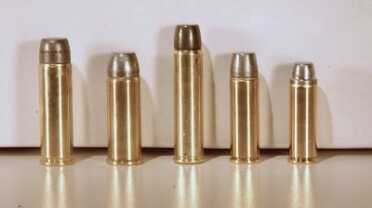
The .500 S&W Mag. round (left) is shown next to the .500 Linebaugh, .460 S&W Mag., .454 Casull and .44 Mag. rounds.
What Buchel and Brown ended up with is a rifle about halfway the size of an 1886 and an 1892 Winchester, hence the moniker Model 89. Parts for the rifle are made by stock removal on CNC machinery. There are no investment cast parts in this rifle, nor are there any forgings. As the company gets on its feet parts are made by an outside contractor located in the United States. The walnut for the stock comes from Missouri. Everything about this rifle is American designed and made.
Just as there is even with established manufacturers, there have been some birthing pains in getting this rifle to market. Delays in parts availability, along with questions as to whether the parts delivered are exactly up to specs, combined with an enthusiastic customer base have made getting the rifles out the door on a timely basis a challenge. It was at least three years ago when I first saw a prototype Model 89 at the SHOT Show Media Day; I only received my test sample less than a month ago—and, mind you, Big Horn Armory is less than 10 miles from my home. Buchel told me that most of the issues have been worked out, and now the turnaround time from order to delivery is about two months.
When You Need It …
In terms of real-world practicality, the Model 89 is something of a niche rifle. It most certainly is not the all-around deer, elk and pronghorn rifle so popular in the West now. Rather, it is a rifle designed to deliver a solid punch to feral swine and bears at moderate range—say 200 yards or less. My range time showed me that a careful shot with superb eyesight might be able to stretch that to as much as 300 yards, but for most of us mere mortals two football fields should be considered max. I was able to hit an 18-inch square gong at 300 yards about four shots out of ten from a benchrest. A better shot with better eyes probably could pick up perhaps three more of those dingers at that range.
[one_half]
[/one_half]
[one_half_last]
[/one_half_last]
My sample Model 89 showed excellent workmanship throughout the metal and wood. I had some initial concerns that the curved lever might prove painful under the stout recoil of the big .50-cal., but those concerns proved meaningless. There’s plenty of room even for my bratwurst-sized digits in the loop, and the pistol grip helps greatly in controlling the rifle. The otherwise traditional look and lines of this rifle are melded with a couple of modernizations to help in its handling.
First, the traditional two-piece walnut stock is shod with a one-inch-thick Pachmayr Decelerator recoil pad. As a traditionalist, I normally tend to favor the old crescent-style steel buttplate—wickedly beautiful and equally wicked on the shoulder. Here is where good sense trumps tradition; the substantial recoil pad allows one to run this rifle without bludgeoning one’s shoulder into a massive hematoma. Too, a Skinner receiver-mounted aperture sight replaces the traditional buckhorn or semi-buckhorn sight usually seen on a lever action. This one is threaded in case you want to add a smaller, more precise peep to it, but the ghost-ring sight picture is perfect for this kind of rifle.
There are two basic versions of the Model 89—rifle and carbine. Interestingly, because the rifle has a half magazine and the carbine is full length, the carbine holds two more rounds than the rifle. On the company’s website, BHA offers a plethora of options and upgrades. Buchel even showed me a prototype receiver with color casehardening for those customers who demand the most beauty in their guns.
Hands On
I divided my range time into two sessions, primarily because the wind blew me off the range on the first one. My plans were to include at least three loads to wring out the rifle, but one proved too dangerous to shoot. Cor-Bon loads the Barnes 325-grain DPX bullet in the .500 S&W Mag, and in the revolver it is a fine load. But the pointed hollowpoint would sit squarely on the primer of the next cartridge in the tubular magazine, and that is a major no-no.
[one_half]

The open top receiver allows for ejected rounds or fired cases to come out the top of the Model 89. Note the visible shell lifter.
[/one_half]
[one_half_last]
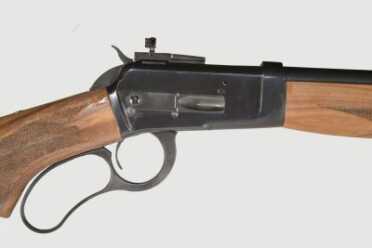
The classic lines of the Model 89 receiver and curved lever should appeal to traditional lever-action fans.
[/one_half_last]
It would be unrealistic to expect sub-moa groups with a rifle of this type. Range limitations include the eyesight of the shooter and his or her tolerance for and ability to control recoil. I would not characterize the recoil as punishing, but you do need to hang on to this rifle and control it in order to extract all of its inherent accuracy. As lever actions go, the stock on the Model 89 is straighter than on most other lever-guns—noticeably straighter than on a Model 94 Winchester, for example—and this helps with recoil handling. The drop at the comb is but 3/4 inch. If I had to complain—and this is really nit-picking—I’d say that the drop could be reduced another 1/8 to 1/4 inch because of the relatively high aperture sight mounted on the receiver. The centerline of the aperture is 1 1/4 inches above the centerline of the bore—nearly as high as most scopes—and I found it a bit difficult to get a firm cheek weld with a good sight picture. Nonetheless, the Model 89 turned in a respectable average of 3 1/2-inch groups at 100 yards. That’s plenty good for the brush buster where 100 yards is a very long shot.
The 7 1/2- to 7 3/4-pound weight isn’t too much of a burden to pack, considering the power this rifle delivers. If I were traipsing around bear country in Alaska, the stainless steel version would be a very comforting companion. This is not a cheapie “everyman” gun with a base price of $2,699, but quality doesn’t come at bargain-basement prices. You get what you pay for!
For more information, visit https://www.bighornarmory.com/catalog/1/big-horn-armory-products/.
To purchase on GunsAmerica.com, click this link: https://www.gunsamerica.com/Search.aspx?T=big%20horn%20armory.

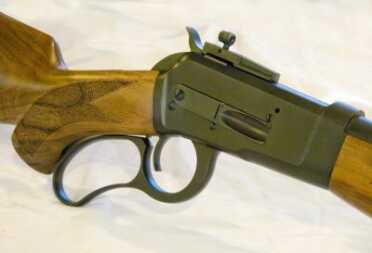

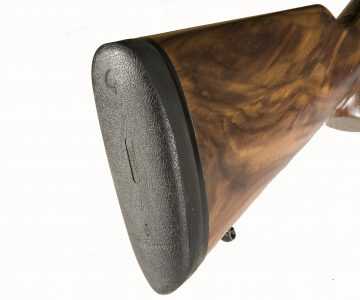
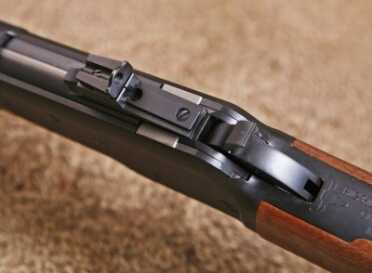
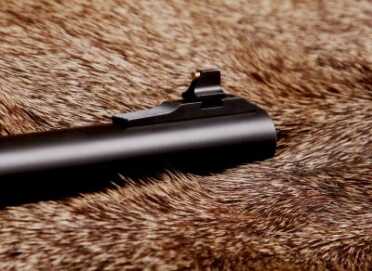
Think I’ll just stick to my Browning BLR in .325WSM it will take down anything that walks the face of the Earth . Looks as good or better and the action is way smoother. Guess it’s just a matter of what one likes to shoot
I have had my 89 for about 3 years. I’ve put around 250 rounds through it using an assortment of manufacturer ammunitions(I now use my own hand loads).The rifle has performed without any malfunctions. The accuracy is what might be expected 1.5″ -3″ 100yds -200yds with open sites. I did order the fiber optic front site coupled with a Skinner rear site. It is a fun rifle to shoot. I purchased the rifle, in part, because I wanted a unique big bore lever action that my friends and I could use at the farm. Something unique for the old gang to go back to the city and talk about with the urban cowboy’s.
I myself use it for coyote control……makes a hell of noise either scares them to death or when I get lucky I gut and skin them with a single shot.
First, I’d like to know where the leather cheek piece came from. I have a couple that I like, but they don’t
have cartridge loops. I’d like one for my production Henry LR .308 which has even nicer wood than the
gun in this article. I paid $825 for it brand new. Can’t say enough about the Henry products.
Second, for those who think the .500 rifle would kick too much – man up. It is a hand gun cartridge and while the
recoil of the revolver is substantial, it is not unmanageable. It is much less than a 12 ga slug which kicks more than
my 7 mag or .300 wsm.
Third, for those that think this Big Horn is too expensive, just don’t buy one. Why denigrate someone who can
afford it and wants one? They are too expensive for me, but more power to anyone that buys one. I don’t own a
Cadillac either but I don’t let envy govern how I treat others that do.
Fourth, Happy New Year. May it be the year that sees some big advancements in our 2A rights. C’mon
Donald – let’s roll.
The cheekpiece is made for Big Horn Armory by a local leather guy and is available directly from Big Horn Armory. HTH!
Lots of morons commenting on this rifle. I have handled one at my local Cabelas and it feels like nothing else in the lever action world. They really did their homework on stock design. The high straight comb points perfectly (unlike the Marlin) and the forearm has a nice belly that just fills your left hand. The metal work is superbly done. The rifle is made from 17-4 stainless and finished in hard Nitride so is not going to scratch up or corrode. This rifle is not made for benchrest and the addition of optics. The Skinner aperture sight is unusual but works well for the use. I also live in Alaska and can full well appreciate the intended use for this rifle. In my opinion this rifle is to lever actions what Freedom Arms is to single action revolvers. If I had to give it negative remarks (other than price which is subjective), the option of a laminate stock seems to have gone away for some reason. Laminate would be cheaper and more durable for Alaskan use.
I see your points. Can I get upgraded from moron to, dullard?
Haha! Actually I’ll upgrade you even higher to Objective Analyzer as your posts offered constructive options without blindly criticizing the rifle. I forgot to mention the author didn’t even do his research as the article mistakenly referred to the rifle as blued when in fact they are all stainless 17-4, with the option of having it hard nitrided. The author states at the end; “If I were traipsing around bear country in Alaska, the stainless steel version would be a very comforting companion.” Uh Mr. Campbell, they are ALL stainless and the Nitride versions are very attractive with deep matte black finish.
Haha! Actually your posts offered some constructive options to the rifle rather than blind criticism. Please consider yourself upgraded to “Critical Analyst” at this time. I forget to point out that the author incorrectly stated the rifle could be had “Blued” when in fact, all the options are made from 17-4 stainless. The option of a hard nitriding gives the rifle an attractive matte black finish which he must have mistaken for blued.
Sad fact is, by the time most of us working stiff, flatlanders save up enough for this beautiful carbine and our dream Alaskan adventure, after paying off the mortgage, putting the kids through college, fixing the roof, new furnace, siding, bathrooms, and kitchen, and 8-10 automobiles, we will have to save a bit further for the wheelchair mount. By the time we get saved for the wheelchair mount, ya might as well through-in the casket scabbard.
Wouldn’t it be easier to re barrel a 1886 Winchester? I had a 86 re barreled and chambered to .50-110, couldn’t one be redone to .50 S&W You can pick up a well used 86 for around 1k ( at least I did 5 years ago from Cabelas) Or use one of the repro’s.
Maybe more to this than I know, just saying.
Your msrp can go where the sun don’t shine. $335.00 for a H&R or $700 for Tompson Centerfire 500 S&W MAG. Quit Trying to rip off the American people.
No body is trying to rip off Americans. If you can’t afford a fine gun, pick up a stone and throw it really hard at the head of your intended quarry. Last I checked, most good rocks are pretty inexpensive or free. although you may have to drive your Yugo around the vacant lot a few times to find one.
Happy 2017! 2nd Amendment Lives!!
H&R and Thompson Centerfire aren’t going to make a follow up very quickly, where this you can dump 8 rounds in a few seconds at that charging Grizzly..
The fact that the designers went to a lot of effort to successfully fit that huge case into a lever gun proves that they are pretty smart people. Then why, I ask myself, did they decide to mount the rear sight on a movable part of the rifle’s action – right where your hand goes when you carry the piece one-handed? They must have seen lots of lever guns with a Lyman peep sight solidly mounted to the left side of the action. The author should at least have mentioned why they chose to do it their way. And then this – “Since the .500 S&W Mag is nearly as long as the .44 Mag case” – doesn’t anyone proofread anymore?
Very nice article. I applaud Big Horn Armory for the work they have done and in demonstrating great American craftsmanship. As far as cost is concerned, I was able to read and understand what was written in the article (no MIM parts, high quality parts and materials, excellent workmanship, American made, etcetera). This does not seem to me, to be a mass production affair, but leaning more heavily towards a custom/built to order rifle. Maybe it is the lack of understanding of “getting what you pay for” that drives others comments on cost. Maybe it is a lack of understanding manufacturing costs, overhead and profit? What ever it is, it would not be logical to assume you could get a Ferrari at a Ford Focus price point.
If I had to focus my critique, it would be towards the availability of parts 10-20+ years, down the road.
I think I’ll stick with my 6 shot AR 15 with the 50 Beowulf upper on it. It was $400 for the upper and I can switch it out for my 5.56 upper or 300 Blackout upper in 10 seconds. The total for my rifle which isn’t lever action and doesn’t have a fancy wall hanger stock is about $1000. Oh, and it shoots 1″ groups at 100 yards with a 350 grain Hornady JHP. Why doesn’t it make sense to me, unless I’m so rich I have nothing to do but spend money on overpriced items like this, to even buy a lever action these days??
When are they going to build a rifle for the .460 with a 24 inch barrel?
They make this in a .460. But break out the big money as well. I was looking for one and ended up getting the T/C Encore Pro hunter. $600.00
When are the Lever ACTION MFG going to start threading their barrels !
Mossberg builds a lever action 30-30 with a threaded barrel. The ar15 stock is adjustable and fits all size people. My only complaint, the lever is too small for my hands.
Appears to be a solution to something that has no problems. If you want one of these,wait awhile and the guys that bought one
will have theirs for sale cheap. I can’t imagine the recoil of this firearm. Buy one and you will get an education.
It’s a handgun cartridge, albeit a big one, fired from a rifle for crying out loud. Me thinks you need to turn in your man card if you find recoil from this rifle too much to handle!
I bought the carbine about 3 years ago. Mine is the stainless version with hot maple furniture. It weighs about 8 lbs w/o scope, and tames the S&W500 recoil to that of a 20 ga autoloader. I have #126, and I’m glad I bought it when I did; out the door it was $2700 with fiber optic front sight. This is a hand built custom rifle. At the time, it was the only levergun shooting the S&W 500 cartridge, which is what I wanted. The receiver is milled 17-4 billet stainless, a single cut Krieger barrel, hand selected stock and forend furniture to match each other, soft butt pad, and no MIM. I would prefer it to not have the ejection on top as this requires a picatinny rail for mounting a scope, but the open sights work fine.
The 45/70 is also a pistol cartridge. Go fire a box of those in marlin’s guide gun. When your shoulder and head quite
throbbing ,get back to me with the man card thing.
45-70 is not a pistol cartridge and it doesn’t kick that bad even in a Guide Gun, I have two of them. You’re a moron.
Your not going to see these firearms on the used market very much, and when you do they aren’t going to loose their value much if at all.
Well I hope they are finally building it. I remember reading an article ~4-5 years ago about this company building this rifle. They had a beautiful stainless receivered rifle to accompany it. Never heard anything more about it until now. –ard
Enjoyed the article, will never get one though. It seems the gun was made for the small group that already shoot .500 S&W and want a lever action to match. Like I do with my .45 LC, and like many did in the old west. If you are worried about 1 MOA groups, stick to a bolt action.
Or, just get yourself a Magnum Research BFR revolver in .45-70 to go with your Win 1886, or your Marlin 1895, with more knock-down power. https://www.gunsamerica.com/956180665/MAGNUM-RESEARCH-BFR-REVOLVER-45-70-GVT-7-5-45-70.htm
Save yourself $1500
Price Comparison
Magnum Reserch BFR revolver new in box (NIB): $1100
https://www.gunsamerica.com/956180665/MAGNUM-RESEARCH-BFR-REVOLVER-45-70-GVT-7-5-45-70.htm
VS:
S&W 500 revolver NIB: $1100
https://www.gunsamerica.com/993423862/Smith-Wesson-500.htm
Marlin 1895 Guide Gun NIB, .45-70 Govt, NIB: $565
https://www.gunsamerica.com/913484712/MARLIN-1895-GUIDE-GUN-45-70-GOV-T-BLUE-NEW-1895G-7046.htm
VS:
Big Horn Armory Model 89 in .500 S&W, NIB: $2500
https://www.gunsamerica.com/932782659/Big-Horn-Armory-Model-89.htm
Ballistics Comparison at 50 yds (not adjusted for barrel length)
.45-70 Govt = 2000 ft lbs/sec
.500 S&W = 1100 ft lbs/sec
Ammo Cost Comparison box of 20 (based on random search):
.45-70 Govt. = $45
.500 S&W = $45
.500 Linebaugh there is also the .500 Linebaugh Maxim, both came before the .500 Smith & Wesson.
of the .500 Linebaugh Maxim it’s been said only a few hearty souls can ride this mount…….
By the way thee is also a .475 Linebaugh Maxim out there.
This rifle/carbine has been on the market a number of years now.
It looks like you’re paying for a nice stock (walnut?); which is a shame. On a clays over-under I can understand, but a brush/guide gun you’re going to use exclusively in the field? Only conclusion is this is a colllector’s piece to be hung Ln the wall. Like the wise first poster said: get you a marlin 45-70 for under $600.
From the looks of the cartridges in the first photo, I would venture to guess that they got the wrong picture,,, it appear to be Big Horn Armory’s Model 90 in .460 S&W Mag rather than the Model 89 in .500 S&W Mag
I’m amused at the audacity of these gun makers,
For about $550 or so I can buy a Marlin 1894, Side ejecting, Lever Action, .44 Magnum/.44 Special, 20″ Barrel, w/ 10 Round magazine..
Easy to shoot, ammo is widely available, and cheaper than the ridiculous S&W 500. It has a micro-grooved barrel that enables it to do pin-point shots at 100 yds.
Yup, I take my Marlin 44 Rem-Mag to the range on a clear and windless morning and with a standard hunting scope nicely mounted on top the receiver, I can place the big bore projectile center in a one inch square at 100 yds, no problem.
So, why would I spend $3K on an unstable 50 caliber rifle that cost $2 per shot or more to shoot and isn’t even milled to accept optics…?
The Big Horn Armory is either run by idiots or they’re thinking that there are a lot of stupid people out there buying guns.
Big Horn Armory is not run by Idiots.
There was a lot of R&D as they say went into this rifle/carbine.
They had to design and engineer there own receiver group, mot likely the most expensive section of any firearm.
and design and most likely over engineer it to with stand the forces generated by the .500 Smith & Wesson.
They are most likely a small to mid size company trying to fill a niche.
The Action is based if I remember correctly, between the model 1886 and model 1892, frame wise it’s longer than the model 1892, but shorter than the model 1886, so as to accommodate the over all cartridge length of the .500 S&W, something your Marlin Receiver can not do.
This rifle/carbine one hand you could say is not for you or I at this point in time, but well heeled customers.
60 years ago people like you were saying the samething about the Forty~Four Magnum.
over time, the more weapons are produced and production numbers climb, the cost per round of the .500 S&W will go down.
You don’t want one, so they’re idiots?
Get over yourself.
Having fired a friend’s .460 Smith about ten years ago, I’ve often thought it would make a good cartridge for a lever gun. Never thought much about the .500 in that role.
Too bad the rifle costs a small fortune. Can’t imagine taking something like that on a hunting trip where that pretty stock and fine metal finish is likely to come into contact with dirt, rocks, fence posts you name it. If it could be produced for roughly the same cost as say, a Marlin lever gun they might have something.
It looks like the rear sight is a Marbles in some photos and a Skinner in other photos.
How’s that Marbles hold up to the recoil? I have one of those Marbles sights with the push button elevation change, and it can’t handle centerfire recoil such as .308 Winchester. Perhaps that is why the Skinner is also used?
The guns with a Marbles are older models. Current models are shipped with the Skinner sight.
Hope it comes with a threaded barrel for a silencer at that price ! AR Beawolf is cheaper !
You can order the Model 89 with a threaded barrel. Stay tuned. I’ll have a blog coming up on shooting a suppressed Model 89.
“You get what you pay for!” ???? Hmmmm…….Seems a few companies now are demonstrating how good firearms can be had at affordable prices. Good article. GREAT concept. Love the idea! Maybe in time, the economics will work out for us lay-people. I can definitely see a shorter stainless takedown version of this being popular in big bear country.
a $3000 rifle that shoots 3 1/2 inch groups at 100 yard?. are there really enough people with that much more money than sense? for one third the price you can buy a rifle that will stop any feral hog or bear in its tracks and will shoot one moa as well.
This is a Hunting Rifle, Not a Target Rifle, two different things, lets also remember, it could be the shooter, and it could be his first time. Note there are people out there that will spend Hundred’s of Thousands of Dollars, or Tens of Thousands of Dollars for a Hunting Rifle, Three grand is nothing to these folks.